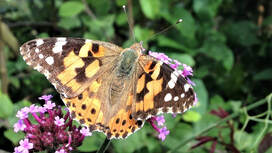|
ooking back on this year's butterflies, Andrew Graham writes 'There are around 60 species of butterflies regularly found in the UK and, with practice and a good eye, they are relatively easy to identify. Gauging their abundance can be used to gauge the population health of other, less easily identified, insect species. 'Part of this is the annual Big Butterfly Count, a popular way to contribute to our knowledge of how many butterflies are around each summer. Unfortunately, the number of butterflies recorded this year was down by 34% on 2019 and the lowest for 11 years. This fall may be due to several factors. One is that many species emerged earlier than usual during the warm spring, so the count might have only caught the end of many species flight periods. 'But this is just one year so we need to look at trends over longer periods. To get a clearer picture, scientists will use these results alongside other data. Across the country, more than 3000 locations are regularly monitored with timed area counts or 'transect walks'. On a transect walk, a recorder slowly walks along the same fixed route once a week, during the right weather conditions, noting the number of each species of butterfly that comes within an imaginary 5m square box around them.  Photo: Elizabeth Forbes Photo: Elizabeth Forbes 'The late David Rear started such a transect in the Tuckingmill area in 2015 and some of us continue his work. The records here since David started doing it in 2015 show that 27 species have been seen at one time or another on the transect, that different species do better in some years than others and that a small number of species only crop up only once or twice. For example, last year painted ladies visited the UK in huge numbers and 56 were seen on the transect but were completely absent this year, reflecting the national picture. This likely happens when a species has a particularly good year in their favoured habitat and spreads out looking for new breeding locations and this is good news for anyone trying to create a wildflower meadow: with time, the butterflies will find it.' 'Don't read too much into the absence of Essex Skipper in 2018 and 2019 - in those years I was just recording all small orange skippers as Small/Essex but started looking a bit closer this year (since buying myself some "butterflying" binos which focus down a lot closer than my birding binos so I can get closer to look at the antennae).
'From a statistical point of view I am not sure one can read too much into what looks like a possible overall downward trend in numbers, although we would obviously be happier if they were going up. But most disappointing for me was the fact that the very good last brood of Small Coppers elsewhere wasn't reflected at Tuckingmill.' Comments are closed.
|
Photo: Avocets (Izzy Fry)
The headers display photos taken by our members. Do get in touch via the Contact Form if you'd like to submit a photo for selection.
Archives
May 2024
Categories
All
|

 RSS Feed
RSS Feed